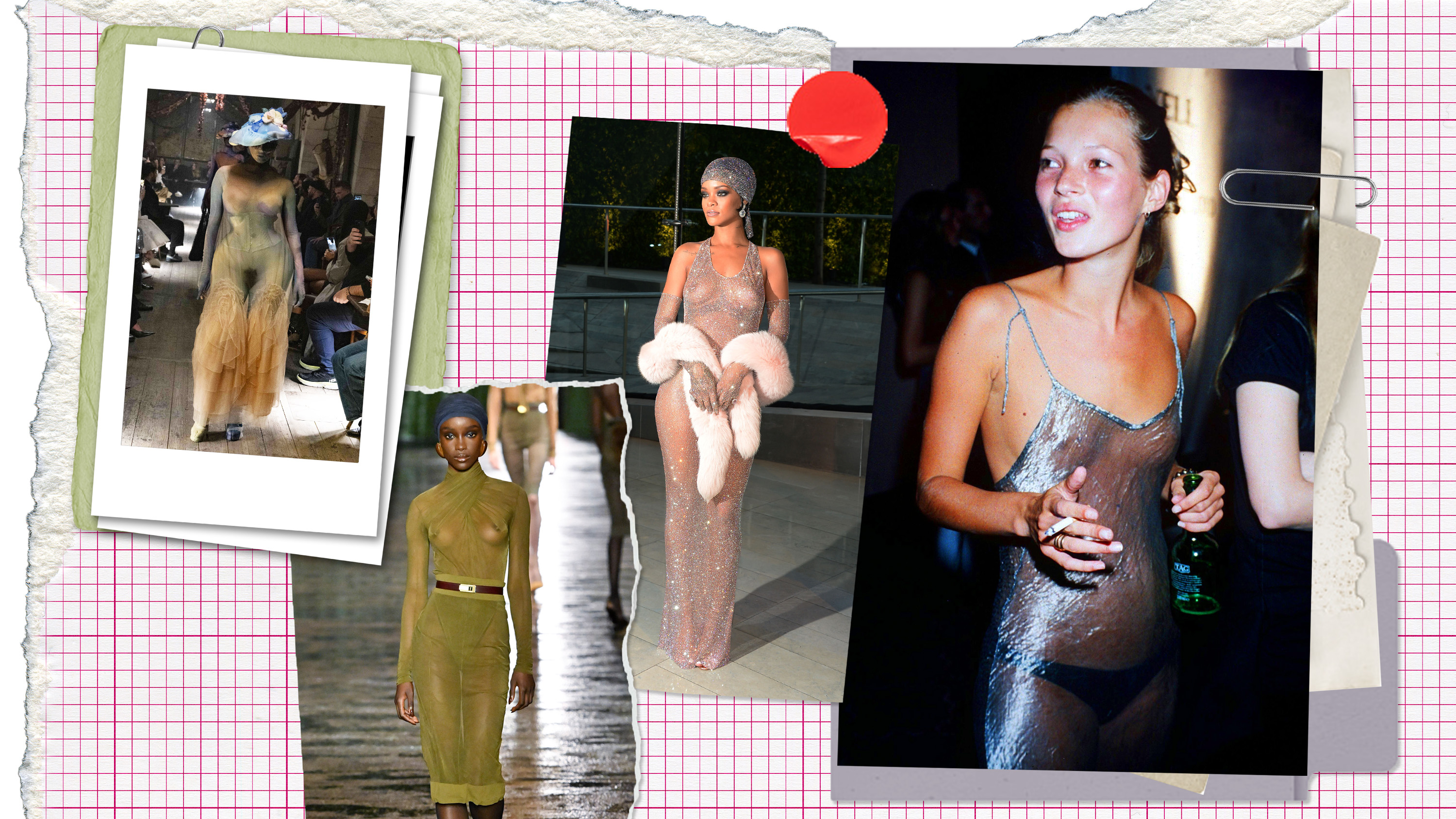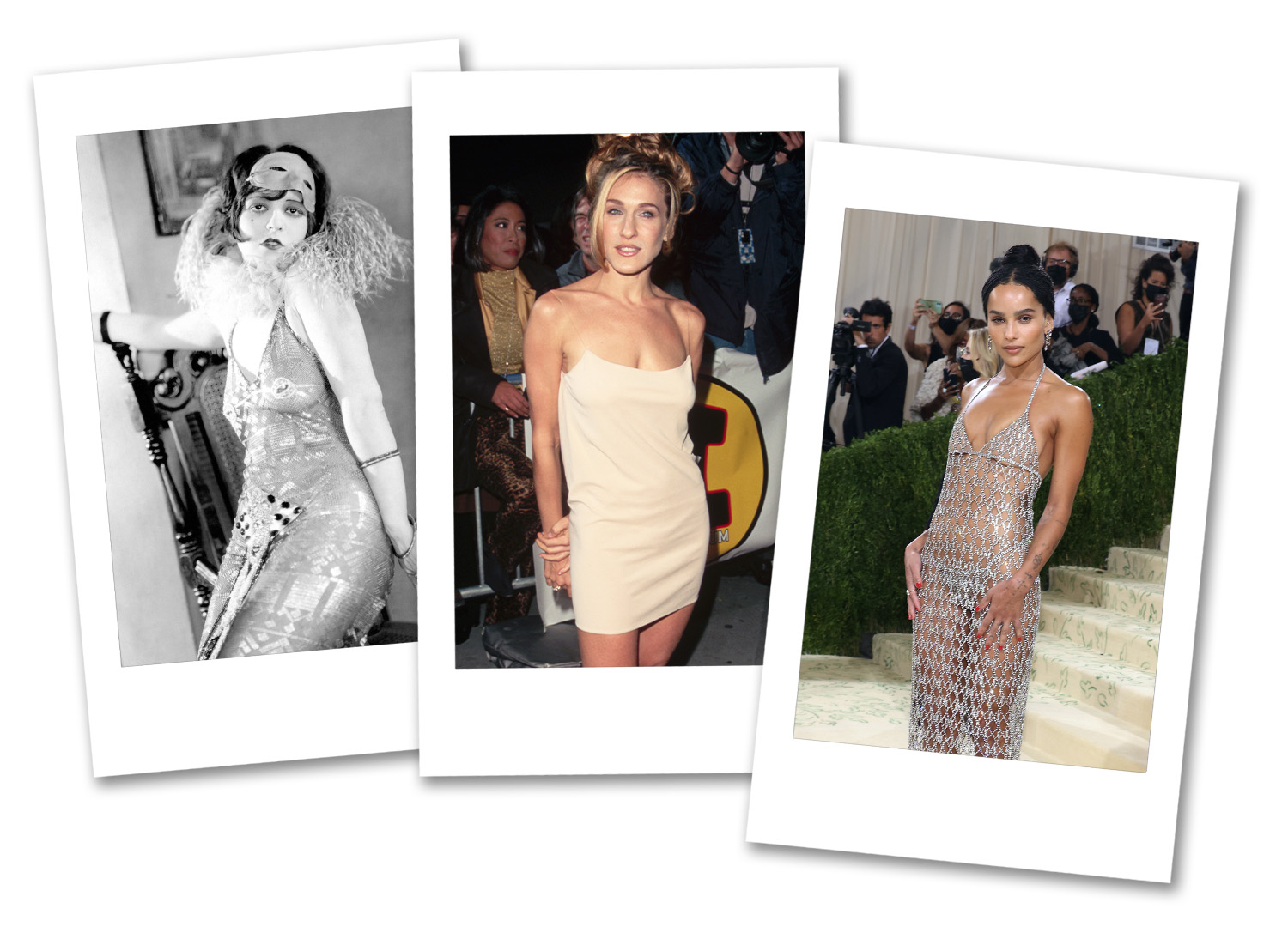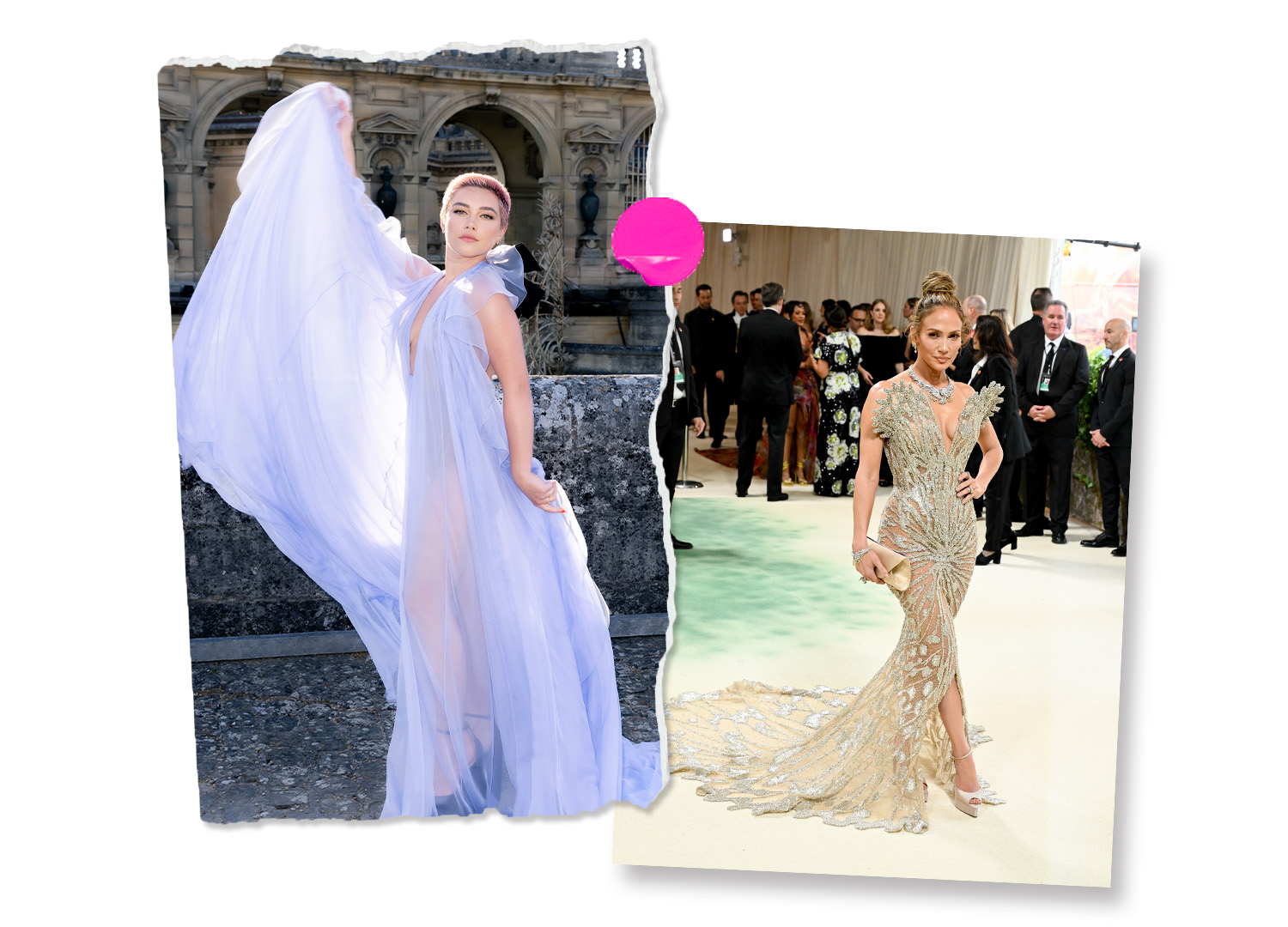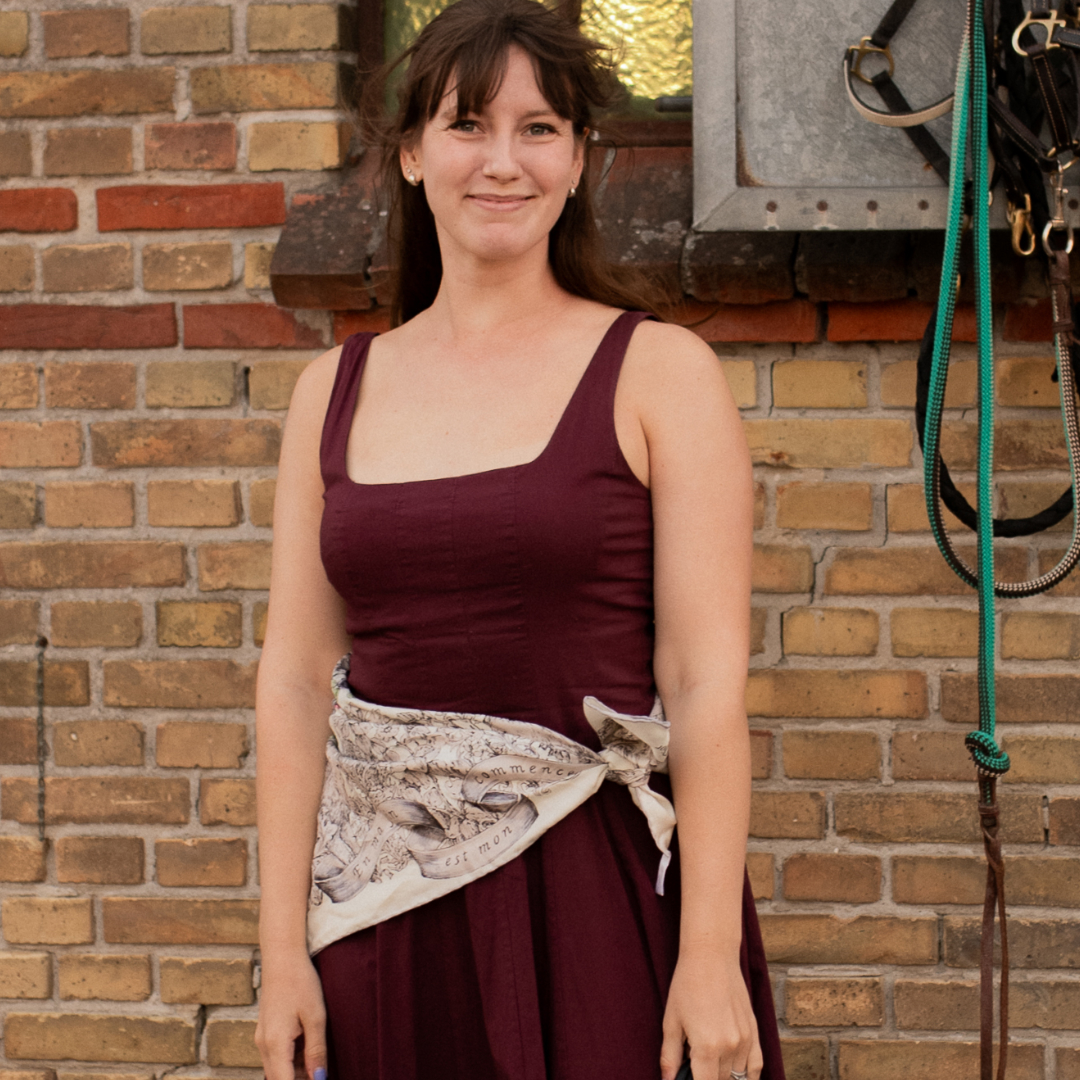The Bare Truth About Naked Dressing
The trend isn't necessarily just for A-listers. But it may not be for all of us, either.


It’s 1993, and Kate Moss is attending Elite Model’s “Look of the Year” party in a completely sheer slip dress and little black briefs. It’s 1998, and Charlotte York tells Carrie Bradshaw her backless DKNY slip for her first date with Big on Sex and the City looks more like a “naked dress.” It’s 2014, and Rihanna is crowned the CFDA’s Fashion Icon, braless under a starry pink net of Swarovski crystals. It’s 2015, and Beyoncé is ascending the Met Gala steps cloaked in a Givenchy gown made up of nude tulle and strategically-placed crystals. It’s 2024, and Emily Ratajkowski or Zoë Kravitz or [insert your preferred KarJenner here] is arriving at some red carpet, somewhere, in a corset or sheath that leaves nothing to the imagination.
All those outfits are variations on the same red carpet theme: naked dressing, which has become a catch-all term for garments that include sheer fabrics, strategic cut-outs, and body-hugging silhouettes that reveal more than they conceal. It’s become the default mode when celebrities want to be seen.

The precedent stretches back decades. In the 1920s, starlets like the original It Girl, Clara Bow, were slipping into semi-sheer garments for the first silent films. The advent of the sexual revolution-meets-women’s-liberation movement in the ‘60s and ‘70s brought more adventurously constructed pieces to the fore with it.
But naked dressing really hit its stride in near-present Hollywood. At this point in my career, by watching red carpet live streams and scrolling social media for a living, I have seen more nearly naked celebrities than I have seen actual naked people in real life.
It’s not just to get in front of an algorithm—though fabrics that free the nipple like Florence Pugh’s controversy-inducing sheer Valentino ball gown in 2023, or expose some side-cheek à la Anya Taylor-Joy’s belted Mugler mini dress this spring, did feel tailored for maximum Did you see this? sharing—but about something much more powerful than that.
It’s something that still feels quite taboo—people are able to co-op this thing that we’re told that we shouldn’t be doing.
Kat Typaldos, celebrity stylist
“In the present, naked dressing is often seen as a statement of confidence and empowerment,” says Shelby Ivey Christie, a fashion and costume historian. “It challenges traditional notions of modesty and body image, allowing individuals to reclaim their bodies and express their style.”
Celebrity stylist Kat Typaldos has dressed clients in sheer outfits for the subtext. “It’s something that still feels quite taboo—people are able to co-op this thing that we’re told that we shouldn’t be doing,” she says. “I think that’s really amazing because, especially in Western and American culture, it’s very ‘shameful’ to be naked. Being able to feel really proud of your body, in a public way, is really exciting.”
Yet by the 15th time someone like Jennifer Lopez wears a naked dress, the ability to shock, awe, empower, or scandalize seems to fade. We already know some public figures will always be more transparent in their red carpet outfits than their interviews, and that they’re not beholden to quite the same dress codes as the general public. So, what about everyone else?

Designers have spent the last year pushing a lingerie-adjacent agenda on shoppers. In an era when women's rights are being rolled back, near see-through clothes are positioned both as sexy and as a shortcut to reclaiming our bodies. The sentiment echoes some of the earliest cases of naked dressing, the historian Ivey Christie notes: In the case of brands like Poster Girl or Mugler, who sell see-through lace bodysuits and latex influenced by strip club attire, “this crossover highlights how subcultures often pave the way for broader trends.”
These days, at least on shopping racks, naked dressing is, in theory, for everyone. Writing this story over the summer, I could find 1,440 results for a “sheer dress” query online at just one department store and 608 for “corset.” Dresses are as revealing at Prada as they are at J.Crew. The only difference is the price tag.
Ivey Christie says that people are in fact seeking out the peek-a-boo moments carried at hundreds of brands, at least in major fashion capitals—just look at the gauzy long-sleeve tops and see-through midi skirts throughout street style in New York and Paris for proof.
I think gaze is all about perspective—some would think this trend is for the male gaze, while I could see how someone would use a sheer look to exude ownership, power, and comfort in relation to their body.
Kelly Augustine, stylist
Women who’ve tried, or at least considered, attending an event in a see-through dress or skirt told me self-acceptance and dressing for a female gaze were the main appeal. “I love figure and shape, so I don’t usually have an adverse reaction to sheer looks,” says Kelly Augustine, a stylist who specializes in dressing clients outside of sample size, with a focus on plus-size fashion. “I think gaze is all about perspective—some would think this trend is for the male gaze, while I could see how someone would use a sheer look to exude ownership, power, and comfort in relation to their body.”
Still, cultural and social barriers can get in the way of everyone feeling comfortable or safe trying the trend. Taking the naked dress plunge can have vastly different outcomes based on the race, body size, and socioeconomic status of the person wearing it. “For instance, Black women and women of color may face different scrutiny or sexualization compared to their white counterparts,” Ivey Christie says.
Plus-size bodies are historically discouraged from showing skin—and Augustine says she’d like to see fuller figures in naked dresses more often. Both on the red carpet and on the sidewalk, body types showing off a near -birthday suit are almost always thin. Women who try them without fitting the runway mold face calls to cover up.
Lauren Chan, a model and size-inclusion advocate, even notes that the options to test drive the naked trend are limited by size to begin with. “It’s most accessible to folks who fit into sample sizes, though it hopefully will be brought to the masses by way of companies catching on to the trend and producing more sizes—but this is the issue fashion always faces,” she says. “We’re on to something new and exciting, and houses, brands and designers make one sample in a two or four.”

Runways reinforce that narrow vision with narrow casting. By the time garments are made, only celebrities or “fashion people” get the option to participate. behind the website “Data, But Make It Fashion,” reported that popularity among consumers for sheer dresses and sheer fabrics had declined 5.4 percent. By the time the trend trickles all the way down into stores, a mindset shift could settle into place: Maybe the big question isn’t who gets to wear a naked dress, but who actually wants to.
This is the beauty of a once-niche look making it to the mainstream: As it becomes more and more normalized to show skin, it’s just as acceptable to opt in as it is to opt out. There is more choice to shop than less; more ways to evolve the styling; more ways to push the definition of who the item emboldens; and ultimately, more ways to find confidence by withholding instead of revealing. Given the trend’s inherently showy nature, some insiders prefer to observe it than to wear it in real life. Evolving social mores haven’t made naked dresses an office-friendly- item, Typaldos jokes. “I actually like the look of this trend, love to see it on a runway and on a red carpet,” Augustine agrees. “But it’s not practical for my everyday life.”
Even celebrities have their limits. “As a stylist, I’d never go to a client and say you should wear this because it’s trending,” Typaldos says. “It’s more like we have a conversation around the garment and what wants to be communicated comes first. A lot of times, wearing a sheer dress isn’t even about this is sheer, which means it’s sexy. It’s more just like, how does this make me feel?” For clients like Meg Stalter, star of Hacks, who wore a sheer Norma Kamali dress and high-waist briefs on the red carpet to the 2022 Emmys, the trend makes them feel present, and empowered, in their bodies.
Earlier this spring, Chan commissioned the independent designer Mario Fugnitto to make her two naked dresses in celebration of her second Sports Illustrated Swimsuit feature. One was a crystalline see-through dress meant to mimic splashing water over a black Skims swimsuit, the other was a white terry cloth mini resembling a soaking wet pool towel. Chan says they’re the most complimented pieces she’s ever worn—even supermodel Lily Aldridge told her she was the best-dressed person at their event. “It was empowering, it was showing the body, it wasn’t hiding it or, quote-unquote, fixing it in any way.” It was also, ultimately, for a red carpet.
This story appears in the 2024 Changemakers Issue of Marie Claire.

Halie LeSavage is the senior fashion news editor at Marie Claire, leading coverage of runway trends, emerging brands, style-meets-culture analysis, and celebrity style (especially Taylor Swift's). Her reporting ranges from profiles of beloved stylists, to exclusive red carpet interviews in her column, The Close-Up, to The A-List Edit, a newsletter where she tests celeb-approved trends IRL.
Halie has reported on style for eight years. Previously, she held fashion editor roles at Glamour, Morning Brew, and Harper’s Bazaar. She has been cited as a fashion expert in The Cut, CNN, Puck, Reuters, and more. In 2022, she earned the Hearst Spotlight Award for excellence in journalism. She holds a bachelor’s degree in English from Harvard College. For more, check out her Substack, Reliable Narrator.